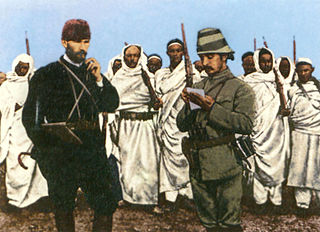
The Congress of Lushnjë, historically documented by the name Mbledhja Kombiare Lushnje, was a conference of Albanian political leaders held from January 28 to January 31, 1920 in Lushnjë, Albania.

The province of Monza and Brianza is an administrative province of Lombardy region, Italy.

Tommaso Tittoni was an Italian diplomat, politician and Knight of the Annunziata. He was Italy's foreign minister from 1903 until 1909, except for a five-month period. He also was interim prime minister for about two weeks in March 1905, making him the shortest-serving prime minister in the history of Italy.

Desio is a town and comune in the Province of Monza and Brianza, Italy.

The Battle of Tobruk (1911) or Nadura Hill Battle occurred on 22 December 1911 during the Italo-Turkish War. The battle was a small engagement primarily known for the involvement and leadership of future Turkish president Mustafa Kemal Atatürk.
The Royal Academy of Italy was a short-lived Italian academy of the Fascist period. It was created on 7 January 1926 by royal decree, but was not inaugurated until 28 October 1929. It was effectively dissolved in 1943 with the fall of Mussolini, and was finally suppressed on 28 September 1944. All of its functions and assets, including the Villa Farnesina, were passed to the Accademia Nazionale dei Lincei. Until 25 April 1945 it continued some activity in the Villa Carlotta on Lake Como near Tremezzo in Lombardy.
Italian colonists were settled in the Dodecanese Islands of the Aegean Sea in the 1930s by the Fascist Italian government of Benito Mussolini, Italy having been in occupation of the Islands since the Italian-Turkish War of 1911.

The Autonomous Republic of Northern Epirus was a short-lived, self-governing entity founded in the aftermath of the Balkan Wars on 28 February 1914, by the local Greek population in southern Albania.
In the aftermath of the First World War, the Adriatic question or Adriatic problem concerned the fate of the territories along the eastern coast of the Adriatic Sea that formerly belonged to the Austro-Hungarian Empire. The roots of the dispute lay in the secret Treaty of London, signed during the war, and in growing nationalism, especially Italian irredentism and Yugoslavism, which led ultimately to the creation of Yugoslavia. The question was a major barrier to agreement at the Paris Peace Conference, but was partially resolved by the Treaty of Rapallo between Italy and Yugoslavia on 12 November 1920.

The Villa Traversi Tittoni, or Villa Cusani Traversi Tittoni is a rural palace in Desio, northern Italy.

Luigj Bumçi was an Albanian Catholic religious and political figure.
The Venizelos–Tittoni agreement was a secret non-binding agreement between the Prime Minister of Greece, Eleftherios Venizelos, and the Italian Minister of Foreign Affairs, Tommaso Tittoni, in July 1919, during the Paris Peace Conference.
Events from the year 1905 in Italy.
Events from the year 1907 in Italy.
Events from the year 1909 in Italy.
Events from the year 1919 in Italy.
The Italian occupation of Adalia, city of Turkey, occurred in the turbulent times after the dismemberment of the Turkish Empire that led to the Treaty of Sèvres.









